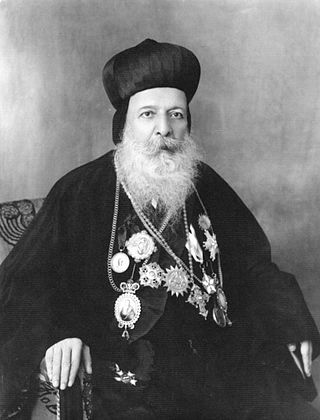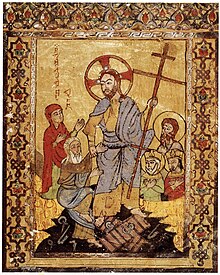
Dayro d-Mor Mattai is a Syriac Orthodox Church monastery on Mount Alfaf in northern Iraq, 20 kilometers northeast of the city of Mosul. It is recognized as one of the oldest Christian monasteries in existence and the oldest Syriac Orthodox monastery in the world.

Mor Ignatius Jacob (Yaʿqub) III was the 121st Syriac Orthodox Patriarch of Antioch and head of the Syriac Orthodox Church 1957–1980. He was skilled in and knowledgeable in Syriac sacral music or Beth Gazo. He re-established the Maphrianate/Catholicate in the Jacobite Syrian Orthodox Church.

St.Ignatius Elias III was the Patriarch of Antioch, and head of the Syriac Orthodox Church from 1917 until his death in 1932.

Mor Ignatius Aphrem I Barsoum was the 120th Syriac Orthodox Patriarch of Antioch and head of the Syriac Orthodox Church from 1933 until his death in 1957. He was consecrated as a Metropolitan and as a Patriarch at a very hard time for the Syriac Orthodox church and its people and parishes and he worked very hard to re-establish the church initiations to where his people moved. He researched, wrote, translated, scriped, and published many scholarly works that included books on the saints, tradition, liturgy, music, and history of Syriac Orthodox Church.

MorIgnatius Abded Aloho II Sattuf also Ignatius Abdullah ll Stephan was the Patriarch of Antioch, and head of the Syriac Orthodox Church from 1906 until his death in 1915.

Ignatius III David was the Patriarch of Antioch and head of the Syriac Orthodox Church from 1222 until 1252.

Mor Julius Yeshu Cicek was the first Syriac Orthodox Church archbishop for Central Europe. In his book Mardutho d Suryoye, he advocated an Aramean identity. He wrote over one hundred works, some of them in Aramaic.
Ignatius Behnam Hadloyo was the Patriarch of Antioch and head of the Syriac Orthodox Church from 1445 until his death in 1454.
Ignatius Jacob I, also known as Jacob al-Khuri or Jacob of al-Nabk, was the Patriarch of Antioch and head of the Syriac Orthodox Church from 1510/1512 until his death in 1517/1519.
Ignatius Hidayat Allah was the Patriarch of Antioch and head of the Syriac Orthodox Church from 1597/1598 until his death in 1639/1640.
Dionysius II was the Patriarch of Antioch and head of the Syriac Orthodox Church from 896/897 until his death in 908/909.
John XIII Aaron bar Ma'dani was the Patriarch of Antioch, and head of the Syriac Orthodox Church from 1252 until his death in 1263.
Ignatius bar Wahib was the Syriac Orthodox Patriarch of Mardin from 1293 until his death in 1333.
Ignatius George II was the Patriarch of Antioch and head of the Syriac Orthodox Church from 1687 until his death in 1708.
Ignatius Saba I, also known as Ignatius Sobo of Salah or Ignatius Sobo Ṣalḥoyo, was the Syriac Orthodox Patriarch of Tur Abdin from 1364 until his death in 1389.
Ignatius Ismail was the Syriac Orthodox Patriarch of Mardin from 1333 until his death in 1365 or 1366.

British Library, Add. 7170 is a Syriac manuscript dated to circa 1220 CE. This is one of the few highly illustrated Middle-Eastern Christian manuscripts from the 13th century. The colophon is lost, but a scribal note indicates that the manuscript was created at the time of Patriarch John and Maphrian Ignatius, who may be identified as John XII of Antioch (1208-1220) and Ignatius III David, respectively, which gives a completion date circa 1215–1220. The location where the manuscript was created is uncertain, but is generally thought to be the Jazira region near Mosul, possibly at the monastery of Deir Mar Mattai, due to artistic similarities with another manuscript securely attributed to Mosul.
The Mor Bar Sauma Monastery was a Syriac Orthodox monastery near Malatya in Turkey. The monastery served as the regular patriarchal residence from the eleventh century until the thirteenth century, and was eventually abandoned in the seventeenth century. It produced five patriarchs and forty-three metropolitan bishops. Between 1074 and 1283 several synods took place at the monastery.
Ignatius Matthew (Matta) was the Patriarch of Antioch and head of the Syriac Orthodox Church from 1782 until his death in 1817.







